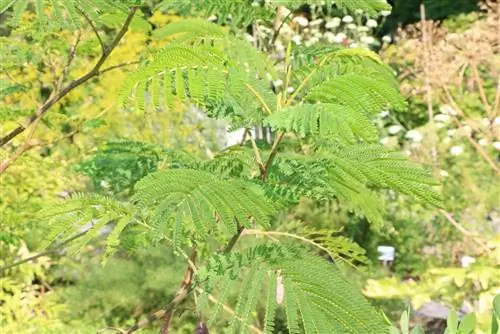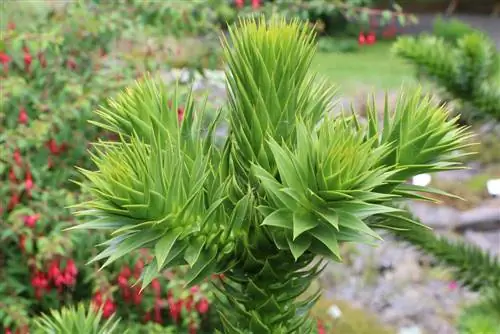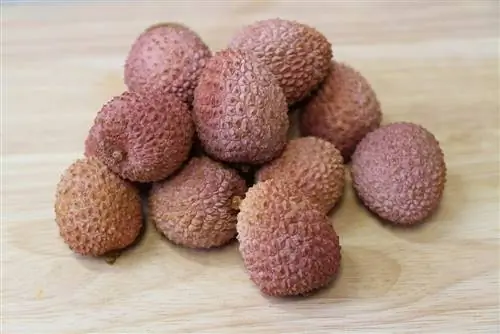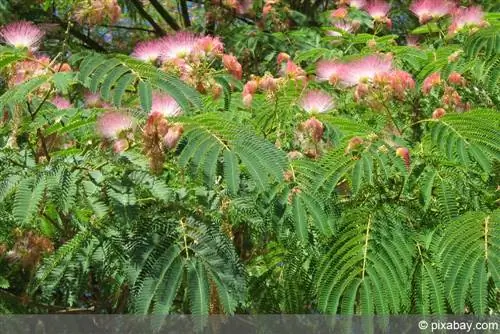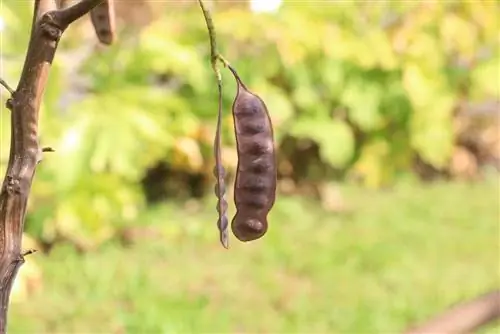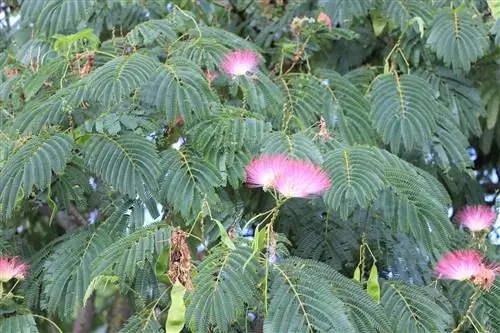- Author admin [email protected].
- Public 2023-12-17 03:39.
- Last modified 2025-01-24 12:45.
The exotic silk acacia with the scientific name Albizia julibrissin comes from subtropical humid to temperate climates. It has made the long journey from New Zealand to our gardens and, as a pot plant or outdoor plant, delights every hobby gardener with its exciting flowers. In return, the ornamental plant expects a certain level of care and a perfect location.
Plants
Some preparation is necessary before planting in the garden. Deeply loosen the substrate at the future location. Since the roots expand moderately in width, a radius three times the size of the root ball is sufficient. Dig a large hole about twice as wide as the root ball. The planting hole is ideally a third deeper than the height of the plant ball.
Good to know:
- Silk trees are heart-rooted plants with compact root balls
- Woods grow very quickly
- reach heights of between four and eight meters within a few years
- require a planting distance between 150 and 200 centimeters
Line the bottom of the planting hole with broken clay, pebbles, quartz sand or expanded clay. This layer acts as a drainage. Insert the plant and fill the gaps with excavated soil that you have enriched with compost. Press the soil firmly. This measure closes the soil so that the roots come into contact with the substrate. Water the root ball moderately.
Tip:
Ensure stability right from the start by putting additional supports in the ground. Choose straight and non-flexible poles, as arched growth cannot be compensated for afterwards.
pot planting

Albizia julibrissin can be planted at a young age in sufficiently large pots. Choose a clay pot as it can regulate the moisture in the substrate. Microscopic water droplets can reach the outside through the pores, where they evaporate. A plastic container does not conduct moisture to the outside.
This is what sleeping trees need in the pot:
- a constantly moist substrate
- regular nutrient supply
- optimal winter protection
Tip:
Plant a silk tree if you want to give your garden an oriental atmosphere. Its feathery leaves, which fold up at night, exude an exotic character and move elegantly back and forth in gentle gusts of wind.
Location
A silk acacia likes sunny places in the open space. They also thrive in partial shade under taller trees. Choose a sheltered location where the plant is not at risk from wind or frost. A growing location on a south-facing house wall is ideal. Here the silk tree enjoys a lot of sun and the building radiates heat during the winter months, so the location is less at risk of frost.
When choosing a location, you should consider the growth rate of the plants, because under optimal conditions they grow up to eight meters high. In width they can reach dimensions of up to four meters. Do not place the plant too close to the wall of the house to allow unrestricted spread.
Substrate and soil
Albizia julibrissin proves to be an adaptable tree that thrives on different types of soil. It grows on acidic soils with a pH value of 4.8 as well as on slightly alkaline substrates up to 7.3. The roots are sensitive to waterlogging and require a loose substrate that ensures high permeability. Waterlogging promotes putrefactive processes. Fungal spores can settle on the rotten roots, weakening the plant. Heavy clay soils are not suitable for planting silk acacia. You can improve the structure of the soil with sand, gravel or perlite. To ensure that the tree can grow well, you should consider these aspects:
- Substrate should provide nutrients
- Water-permeable structure promotes root he alth
- deeply loosen heavily compacted soils
- Mix sand into the substrate
- ensure dry to moderately humid conditions
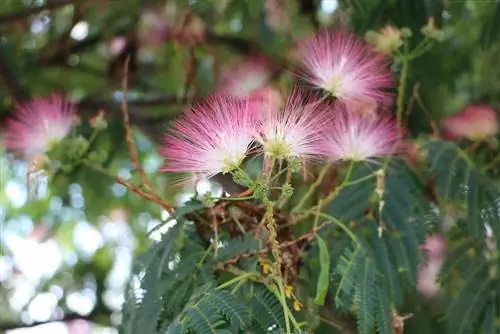
Potted plants prefer a high-quality substrate that retains its permeable structure even after several watering sessions. Normal garden soil or less high-quality potting soil compacts over time so that water cannot drain away well. A homemade mixture of nutrient-rich soil, sand and perlite has a high proportion of large pores that do not retain water.
Pouring
The plants have special requirements for water supply. They tolerate neither dryness nor wetness. Overwatering causes problems for the roots, making the plant more susceptible to disease. If the root ball dries out completely, the water balance in the organism collapses. The plant can no longer supply its leaf mass with sufficient water and nutrients, so the leaves quickly hang limp and wither. Young plants in particular can quickly become overwatered.
How to water correctly:
- on a regular basis every day
- depending on age and size, give around 500 ml of water
- Adapt irrigation to summer and winter
While watering is plentiful in the summer, you should significantly limit the water supply during the winter months. The substrate should not dry out completely. Make sure that the soil is evenly and consistently moist.
Tip:
With a soil moisture meter you can always control the moisture in the substrate. The devices often also provide information about the pH value or incidence of light.
Fertilize
The silk tree is one of the more consuming plants. Their need for nutrients is high during the growth phase between spring and summer. Begin fertilizing in March, just before the leaves unfurl. Work fresh compost into the substrate to ensure the plants get a perfect start to the growing season. The nutrient supply takes place until the end of July. Then stop fertilizing so that the plant can prepare for winter. If you provide the plant with additional care until autumn, the fresh shoots will not be able to mature. This measure stimulates the plant to form further shoots.
The perfectly coordinated nutrient supply:
- Potted plants receive nutrients every 14 days
- Outdoor plants are fertilized every two to four weeks
- two-year-old young plants need fertilizer every six to eight weeks
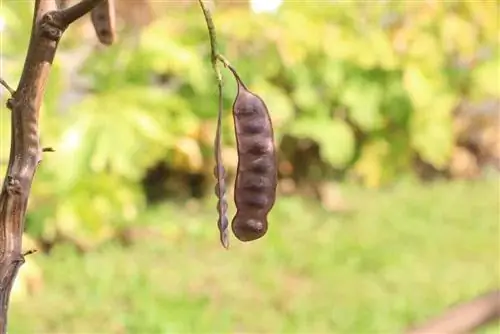
Fertilization is not necessary after you have freshly planted or repotted the plant. The new substrate is already sufficiently enriched with nutrients that the plant will use for the next six to eight weeks. Young plants should not be fertilized in the first year. They first have to mature and are encouraged to grow quickly by an additional supply of nutrients.
Tip:
Avoid nitrogen-based fertilizers. They quickly lead to over-fertilization and weaken the plant, encouraging aphid infestation.
Cutting
If you want to grow the sleeping tree in its natural form, no special pruning measures are necessary. You can give the plant free space to spread and only remove dead inflorescences and bare branches. Pruning is necessary if the plant has been weakened by pests and diseases or is to be transplanted. Removing shoots ensures that the plant regenerates and sprouts freshly. Special cuts are also necessary if you want to shape the silk acacia into a specific shape.
Shrub form
De-tip young specimens regularly by clipping the shoots with your fingernail or cutting them with a sharp knife. This stimulates a bushy growth habit because the plants develop new branches under the breaks. This measure is recommended for potted plants where a shrub-like shape is desired.
Tree shape
If you want to grow a tree-shaped silk acacia, you should avoid regularly trimming the tips. To cultivate the silk tree as a standard tree, regularly remove the lower branches. The tree grows quickly and develops a semi-round and wide crown that is flat and resembles an umbrella. Topiary cuts ensure that the crown does not become out of shape. To do this, shorten any protruding branches. If you cut between the leaves, new shoots will develop below the cuts.
You should pay attention to this:
- cut before the first shoots in May
- Wait for late frosts
- choose a dry day
- do not carry out pruning measures in autumn
- After cutting, cover the plant with fleece to protect it from the sun
Tip:
If the plant rots, you should shorten it to half its height. Always cut directly above a sleeping eye so that the plant can sprout there again.
Propagate

You can propagate your silk tree using seeds that you collect from your plant after the flowering period. Soak the seeds in water at 28 degrees Celsius for at least three hours. The longer the seeds are moist, the better they swell. After a day at the latest, the seeds are scattered on a permeable granulate and pressed lightly. Only cover the seeds lightly with substrate because the seeds need light to germinate. Moisten the granules and place the container in a bright place with temperatures between 20 and 25 degrees Celsius. To increase the humidity, you should cover the plant pot with transparent foil. Make sure the soil moisture is even.
This is what happens afterwards:
- remove foil after germination
- Prick out young plants when they are five centimeters tall
- Transplant into normal substrate from a height of between 15 and 20 centimeters
- put outside in the first summer
- plant in the desired location in the second year
Wintering
Whether your silk tree needs winter protection depends on the variety. Not every specimen is winter hardy. Most sleeping trees can tolerate double-digit temperatures for short periods of time. If you are unsure, you should protect the shrub from the cold as a preventive measure. Cover the substrate around the base of the trunk with several layers of brushwood. Alternatively, you can use garden fleece or bamboo mats. Also cover the crown with a fleece to protect it from the wind.
Container and young plants overwinter like this:
- take it in when the temperature is below ten degrees Celsius
- provide frost-free winter quarters
- place in a bright place
- water moderately
A warm wintering is also possible. Place the pot in a bright room with mild temperatures between 15 and 20 degrees Celsius and ensure moderate humidity. Mist the leaves regularly with water. If the plant does not go dormant in winter, next year's flowers may fail.

